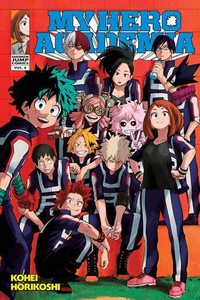Review
by Nick Creamer,My Hero Academia
GN 4
| Synopsis: |  |
||
Having literally soared past his competitors, Midoriya ended the first round of the academy sports festival in first place, with a cool ten million points. But as the second round begins, Midoriya realizes his early victory is actually something of a liability - with students pairing into groups of four and competing to steal each other's points, Midoriya has successfully painted a gigantic target on his back. Will Midoriya be able to find allies and overcome this challenge, and will he be ready for whatever lies beyond? |
|||
| Review: | |||
My Hero Academia's third volume was a bit of a lesser volume, focusing mostly on the cooldown period between two larger arcs. It was fun, but it was the manga leaning on its fundamental assets, and not truly demonstrating what it could really do. But that volume's loss is the fourth's gain - focusing on the second and third rounds of U.A.'s sports festival, it's non-stop action from start to finish, interspersed with excellent fragments of character writing and heroic philosophy. My Hero Academia is a fundamentally excellent shounen, and this volume demonstrates the manga at its absolute best. The early chapters rush quickly through the second round's setup, as Midoriya and his classmates assemble into groups of four in order to protect their own combined points while attempting to steal others. This premise not only flips Midoriya's first round advantage on its head, it lets a much wider array of students show off their quirks, and even combine them together for a variety of compelling combo attacks. A great shounen manga can't simply rely on strong characters bashing each other over the head. Pure displays of strength get boring, even when they're visually interesting - even My Hero Academia's third volume demonstrated that, through the lackluster conclusion of the villain arc. In the best shounen manga, a diverse spread of powers offer the tools necessary to build creative tactical scenarios, where the different ways specific powers stack up against each other foster unique action setpieces. The festival's second round clearly demonstrates the power of this approach, as Midoriya, Bakugo, and Shoto each assemble teams of would-be heroes designed to complement their own powers. The result is a thrilling game of cat and mouse, as Midoriya, Uraraka, and their two companions attempt to simply defend Midoriya's points, while Shoto acts as the arena heavyweight and Bakugo performs tactical strikes with teammates chosen to amplify his own powers. It's fast-paced and creative and exhilarating, exactly the kind of action-packed drama you'd hope for from a manga predicated on a world full of superheroes. The setup allows over a dozen characters to be relevant without detracting at all from the sequence's clear focus and dramatic priorities. It's a brilliantly conceived and smartly executed highlight in a manga already defined by consistent highs. The tournament's third round switches to a traditional one on one tournament, which allows another of My Hero Academia's strengths to shine - its character writing. All of the things that have always set My Hero Academia apart as far as character and tone go are still present here - Midoriya is still a uniquely compelling protagonist, and the positive spirit he shares with his close friends is still a welcome reprieve from tragedy-focused antiheroes. But the broadening perspective of the sports festival allows several other characters to take the stage as well, with both Shoto and general studies superstar Hitoshi Shinso getting some excellent moments. Their motivations are very different from Midoriya's, but each are understandable in their own way, and their feelings add some nice texture to My Hero Academia's consistently thoughtful take on the nature of heroism. My Hero Academia's artwork is well up to the task of illustrating this volume's many climactic showdowns. The manga's thick, angular linework and strong visual effects give its clashes a real sense of impact and beauty, and the occasional visual gags nicely offset the generally high dramatic tenor (I particularly liked the moment where the force of Midoriya's tears actually propelled him downwards into the ground). There weren't quite that many standout visual setpieces in this volume, and some pages of the second round got a little visually confusing, but the art is still generally excellent. Overall, My Hero Academia's fourth volume is likely its best volume yet, a satisfying page-turner that effortlessly juggles convincing drama and a consistently upbeat attitude. Its characters are diverse and likable, its action scenes are creative and plentiful, and its tone and incidental conversations nail what makes superheroes compelling. My Hero Academia brings shounen storytelling and superhero worldbuilding together, and in doing so demonstrates each of these grand traditions at their best. |
| Grade: | |||
|
Overall : A
Story : A
Art : A-
+ The school festival offers plenty of exciting and creative clashes while also elaborating on its compelling cast. Great fights, great themes, great everything. |
|||
| discuss this in the forum (4 posts) | | |||
| Production Info: | ||
|
Full encyclopedia details about Release information about |
||